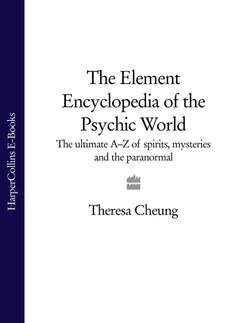Читать книгу The Element Encyclopedia of the Psychic World: The Ultimate A–Z of Spirits, Mysteries and the Paranormal - Theresa Cheung, Theresa Cheung - Страница 196
COLOURS
ОглавлениеEvery colour is believed to vibrate with its own energy and to have specific effects on individuals. Seven colours in particular -red, orange, yellow, green, blue, indigo and violet, the colours of the rainbow - have carried religious, occult, mystical and healing meanings since ancient times.
Red, which has the longest wavelength, typically represents the physical and material, while violet, the shortest wavelength, represents spirituality and enlightenment. White, the combination of all colours, is usually associated with divinity and purity, while black, the absence of all colour, is associated by some people with evil but by others with protection and comfort, like the warm darkness of a summer night. Traditionally, the body is associated with red, the mind with yellow and the spirit with blue.
Healing with colour has a long tradition dating back to ancient times. The Pythagoreans believed that white light, the Godhead, contains all sound and colour and that the seven colours of the spectrum correspond to the seven planets and the eight notes of the musical scale (both the first and the eighth notes are red).
Despite the fact that colour healing has been in use for centuries, it wasn’t until the late nineteenth century that it began to receive attention in the West. In 1878 Edwin Babbitt published The Principles of Light and Colour, reaffirming the Pythagorean correspondences of music, colour and sound, and by so doing drew attention to the potential of colour healing. In the 1930s Dinshah Ghadiali proposed that imbalances are created by too much or too little of particular colours, and that balance can be restored with the use of coloured lights. Today modern colour therapy or healing is a controversial but popular alternative medicine technique involving the use of coloured lamps as well as coloured foods and drinks in coloured containers.
Modern science is able to provide evidence for some of the ancient claims about colour. In the 1970s and 1980s it was shown that coloured light triggers biochemical reactions in the body. Later research confirmed that blues and greens have a soothing effect and help lower stress, brain-wave activity and blood pressure. Warm colours such as orange and red have been shown to have a stimulating effect. Pink has been shown to have a relaxing effect in the short term, although in the longer term it can trigger irritability. Each colour is associated with a specific vibrational frequency, so when there is a predominance of one or two colours in the environment that vibrational frequency -and the characteristics or qualities associated with that frequency - will tend to influence the activities conducted in that environment and the attitude of those in it. It is small wonder, then, that many psychologists use colour to produce beneficial effects in the home, workplace and in hospitals, and in visualization techniques patients are asked to imagine themselves bathed in a particular colour to encourage healing in mind, body and spirit.
